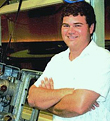|
Author
|
Topic: Reflector Materials; Are there any data about them?
|
|
|
Monte L Fullmer
Film God

Posts: 8367
From: Nampa, Idaho, USA
Registered: Nov 2004
|
 posted 06-16-2007 03:41 AM
posted 06-16-2007 03:41 AM




Dichronic (red) mirrors are great since the heat goes through the glass while the light is reflected, but the simple downside is that these mirrors are pricey and if a bulb blows, so does the mirror.
Metal mirrors reflects everything out -from infared to ultra violet through the lamphouse, but the metal acts like a big heatsink absorbing some of the heat from the bulb before that heat goes through the machine. Also, if the bulb blows, the quartz shards might just scrape up the mirror some to where it can really ding it up, but the mirror doesn't destroy itself if it were glass.
With dichronic mirrors, the light output is greater than black chrome metal mirrors - why in the old days of 3-D with carbon arc light, lamphouses were equipped with these dichronic mirrors to get as much as the light out as possible than what the old silver plated glass mirrors would yield.
I work in a drive-in that the lamphouse has a dichronic glass mirror and can easily tell that I'm getting better light out than if this lamphouse would have a metal mirror.
Do a google search on this topic...might find something.
| IP: Logged
|
|
|
|
|
|
|
|
|
|
|
|
|
|
|
|
|
|
|
|
|
|
|
|
|
|
|
|

 Home
Home
 Products
Products
 Store
Store
 Forum
Forum
 Warehouse
Warehouse
 Contact Us
Contact Us




 Printer-friendly view of this topic
Printer-friendly view of this topic







![[Big Grin]](biggrin.gif) These mirrors are also called "cold mirrors" because they reflect visible light while letting IR pass through without reflecting it.
These mirrors are also called "cold mirrors" because they reflect visible light while letting IR pass through without reflecting it.




![[Cool]](cool.gif) .
.


